While all décor elements are important in their own way, flooring is one that will make or break the rooms in your clients’ home. It takes a trained eye to determine which type of flooring to use in each space, and there are many factors to consider when making the call!
If you’re just starting out as a home decorator, don’t worry – we’ve put together a handy guide to flooring, and invite you to walk through each room in the home with us. You’ll get a sense of what each room needs, which kind of flooring works best, and how to best advise your client throughout the process. Read on and be inspired!
The Living Room
Let’s start in a high traffic area, and one that will definitely suffer from the wrong type of flooring. When it comes to the living room, design professionals need to take many factors into consideration, such as who uses the space, how the client wants the room to feel, and which type of flooring is the most practical. Join us as we walk through a few flooring options for the living room (and take common factors into consideration!):
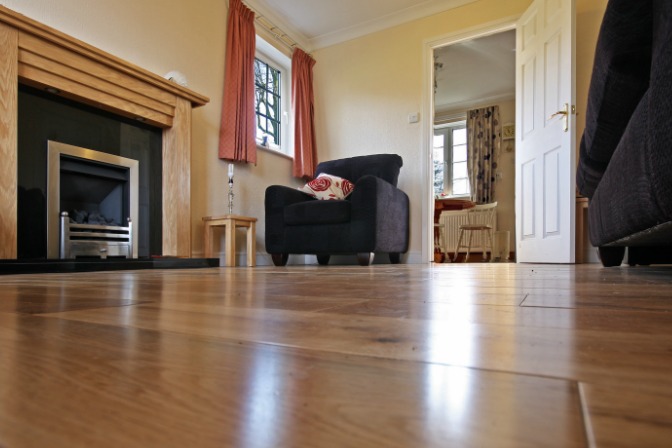
Laminate: Inexpensive and easy to install, this type of flooring is a seriously popular choice! Laminate floors are made up of different wood-based materials and covered with a photo imprint which is applied to each board. Although not as polished and pristine as hardwood flooring, laminate is quite durable, which is a priority for your clients’ living area (especially if they have children or pets).
Generally, laminate flooring is around $2.00 or less per square foot, making it an extremely budget-friendly option.
Hardwood: When it comes to custom interiors, home decorators will find that the majority of their clients long for hardwood, and this will come as no surprise. Hardwood is almost always preferred over carpet, as it creates an elegant look that is much easier to care for and clean. Laminate may be a popular choice, but hardwood flooring is number one on everyone’s list (although not always affordable).
However, it is more complicated than laminate in terms of the choices available – as the expert, you’ll need to help your clients decide on the type of hardwood they want to use in their living room, and this can be challenging! Cherry and oak are extremely popular, but you need to consider your client’s existing home interior and whether these types of wood will complement their decor. If not, there are other types of hardwood available but they will likely be more expensive.
Carpet: Every client is different, and as such, not all clients will desire laminate or hardwood as the flooring in their living room. Although it doesn’t always have the best reputation, carpet is a viable option for your client’s main living area!
Obviously, carpet is a much warmer option than bare floor, and although this may seem like a small feature, it can be a determining factor for a homeowner who loves the idea of a warm room where their feet are never cold. In a colder climate, or during the winter season, carpet will actually retain warmth which not only is an energy conservation benefit but a huge plus for clients.

When it comes to safety for children and pets, carpet wins! As a softer surface, carpet reduces slips and falls, and acts as a cushion when children (or pets) are playing and accidentally take a tumble. This is a huge selling point for your clients. Finally, carpet masks noise, so if your client lives in an apartment or there’s a bedroom underneath the living room, the noise won’t travel as strongly.
We’ve listed all the benefits of carpet in the living room, but it still remains a less popular flooring choice than hardwood and laminate. If your clients are wary of wall-to-wall carpet, area rugs are an excellent solution, as you choose where to place them and don’t have to commit to the entire room. However, full carpet reigns supreme in bedrooms, which brings us to our next space in this guide…
The Bedroom
Next on our list of rooms in the home is the bedroom. After the kitchen, this room is arguably the most important one in the home, as it is where we seek rest and comfort. A great deal of thought and care should go into deciding which type of flooring to use in this space, and carpet and hardwood flooring are among the most popular. Your clients will likely have many bedroom ideas, so let’s explore!
Carpet: Many of the selling features of carpet for your client’s living room also extend to the bedroom – who wants to wake up and place their feet on a cold, hard floor? Carpet in the bedroom also greatly reduces noise and the impact of potential falls, as mentioned earlier.
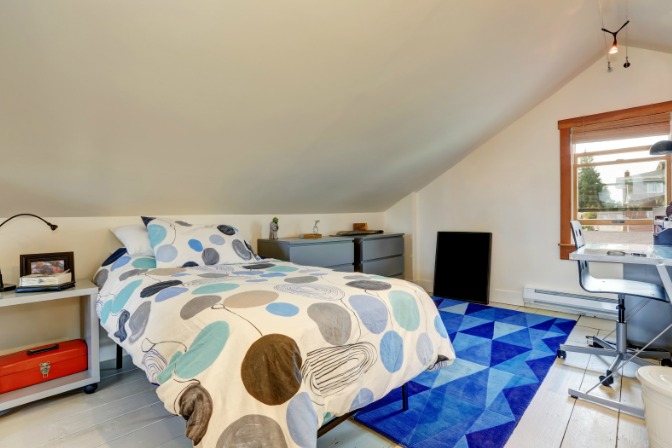
If your clients are afraid of color in their bedroom, you can ease them into it with a colorful rug on the floor, as well as pillows, art, and a colorful bedspread to complement it.
Hardwood or laminate: Similar to the benefits they provide to a living room, hardwood and laminate are also great choices for the bedroom. They’re easy to clean, durable, and in the case of hardwood, very elegant. However, your client may be on the fence about these options due to the fact that they want a cozy, warm atmosphere in their bedroom.
In this case, carpet would be the better option, but you can provide them with the benefits of each in order to help them reach the best decision. It’s important to consider your individual client when advising the best flooring options for their bedroom – this space is very personal and intimate, and its overall feeling will have a strong impact on your client’s life.
The Kitchen
Is there a more important room in the home than the kitchen? It’s where life happens – food is prepared, homework is done, and laughs are shared in this space.When it comes to choosing the best flooring option for the kitchen, tile is a very popular choice, but it comes into competition with other favorite materials…
Tile: When most people think of kitchen flooring, tile is the first option that comes to mind! However, there is much more to tiles than just choosing the right pattern.
Get to know your client’s vision of their kitchen (and their overall home design plans) so you can make the best choice about which type of tiles to use.
Ceramic, porcelain, slate, and granite are just a few – check out our full guide to tiles here!
Hardwood: We have some bad news about hardwood in the kitchen – it’s not ideal.
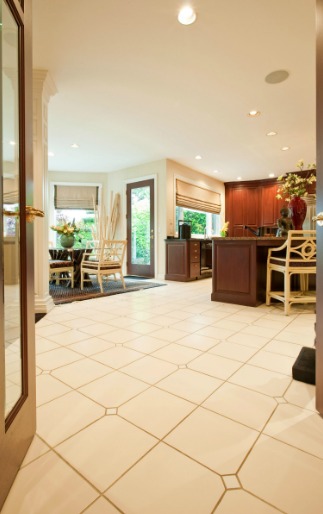
The kitchen is a hub of activity, and this includes spilling food and liquid, as well as dropping (and sometimes breaking) pots, pans, and dishes. This kind of wear and tear works well on tiles, as they are generally moisture-resistant and can stand up to stains and humidity, but hardwood is much more delicate. While some strong types of hardwood such as oak and ash can mask scratches and stains, this doesn’t mean that they are a good choice for your client’s kitchen.
If they have their heart set on hardwood flooring, you’re in for a good deal of work, and should familiarize yourself with bevels (the edges of the wood). Your client will need micro bevels when they purchase the wood for their kitchen floor, instead of regular-sized bevels, as micro bevels will prevent dirt from accumulating between the boards (very important for spills and other dust that can easily appear in the kitchen!). You’ll also want to use a lighter color, so crumbs and dirt are not as visible.
Finally, your client needs to be extremely careful all the time in this space, which is another reason why hardwood is not ideal in the kitchen.
Carpet: While wall-to-wall carpet is not an option for the kitchen, small area rugs are! They are especially helpful for your client to stand on while at the sink, or in front of the stove, and can really add life and texture to the kitchen space.
The Bathroom
We end our flooring journey in another important space – the bathroom. While this room shares some commonalities with the living room, bedroom, and kitchen, it has its own unique needs when it comes to flooring. Keep temperature, client preference, and overall ambience in mind when considering these flooring options!
Vinyl: This is one flooring material we haven’t covered in this guide yet, and with good reason. Highly popular for use exclusively in bathrooms, vinyl is an excellent choice for a space where moisture is inevitable.
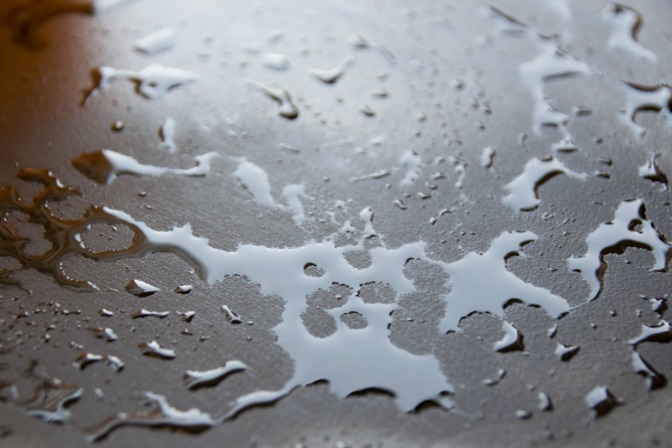
Between the bathtub, the toilet, and the sink, the bathroom floor is going to bear the brunt of water on a regular basis, and instead of tiptoeing around this fact and being overly cautious, why not think ahead and employ a floor that can withstand it? Sheet vinyl is a fantastic choice, as it has zero seams to allow water to seep in. Plus, it comes in a huge variety of different styles to suit your client’s current décor, or to build a new décor around.
Tile: While there are many tiling options to choose from for your client’s kitchen, the list is narrowed down significantly for their bathroom. Porcelain and ceramic tile are the best choices for a room that is so centered around moisture, as these materials are highly waterproof and inexpensive, but also look beautiful and stylish (more so than vinyl).
If your clients are particular about their bathroom being elegant, you’ll definitely want to recommend tile. A good rule of thumb is to understand their home design plans, and bathroom ideas, before making any big decisions. The best part? Certain types of ceramic tile look just like wood or stone, so you can get very creative while using only one type of material!
Pro tip: Porcelain tile can actually be heated for your clients who truly want an enjoyable bathroom experience. Find out how to add heated floors and other elements to warm up your client’s chilly bathroom here.
Laminate or hardwood: We end our list with two materials that can be used in all rooms in the home, but again, are not totally ideal for the bathroom. For clients who can’t imagine any other floor in their bathroom than laminate or hardwood, it is up to you as the design professional to recommend they take serious precautions about protecting the floor from moisture.
As with vinyl, you’ll want to ensure that there are tight seams in between each plank to keep out water, and that your clients are extremely careful. But who wants to exercise caution in their bathroom? Laminate and hardwood are the least desirable flooring options for the bathroom, but all clients are different, so it’s important to be prepared.

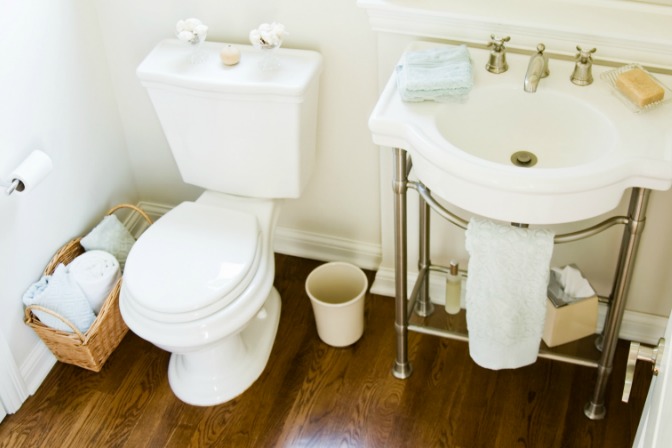

Good demonstration on the installation. I am a floor installer myself detail was very important and you nailed it. Not many floor mechanics show or other professions show that. I like the time details step by step of all the work for the flooring. Thank you so much for sharing the knowledgeable information here.